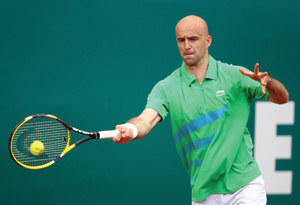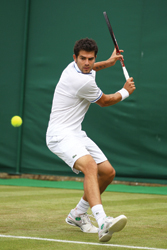When Wimbledon on Wednesday unveils prize money for this year’s fortnight, the news is likely to trigger far more reaction in the sport than what typically greets a historically mundane and quickly forgotten news item about an increase of a few percentage points in the size of the purse.
Why the change? The announcement comes in the wake of ATP players, sources said, recently asking the four Gland Slams to more than double prize money next year, contending the events are keeping a disproportionately high share of revenue. While the Slams this calendar year are likely to award more than $100 million combined in prize money (see chart), that represents at best around 15 percent of revenue, a figure well beneath the norm in most other sports.
Labor battles, common in team sports, are largely foreign in individual sports, where there’s no union and players’ interests conflict based on ranking and home country. But talk of Slam boycotts is percolating through men’s tennis this year, and the new head of the ATP, Brad Drewett, is leading the prize-money effort in the sport. Top players Roger Federer, Rafael Nadal and Novak Djokovic have been involved in the discussions.
“Essentially you have the players thinking they are underpaid and the Grand Slams think they don’t want to pay more, and justifying their position to some extent by saying they plow their profits back into the development of the game in their four countries,” said former ATP CEO Mark Miles. “Players would be fine seeing money come out of their share to see professional tennis promoted, but around the globe.”
The Slams, like the ATP, are not talking publicly, preferring to keep the discussions that began last month private. But sources said the Slams’ position is clear: They invest their profits into grassroots efforts, and it’s unfair to compare tennis to team sports.
In team sports with salary caps, players get a percentage of revenue ranging from around 45 percent in the NFL to 48 percent in the NBA. By contrast, the ATP’s research shows male players at the U.S. Open last year received 4.8 percent of the tournament’s revenue, sources said. Overall, to all competitors (men and women, singles and doubles players), the Open, like the other Slams, generally pays out 12 percent to 15 percent of revenue, so the internal ATP figure might be low.
 |
Former Player Council President Ivan Ljubicic: “We feel like we are not getting the fair share.”
Photo by: GETTY IMAGES
|
The Slams accuse the ATP, sources said, of not seeing the big picture that more prize money would rob the sport’s development, professionally and recreationally. The U.S. Tennis Association’s more than $200 million budget is funded nearly entirely by the Open. That budget finances a minor league circuit, the U.S. Davis Cup and Fed Cup teams, marketing for the U.S. Open Series, and a network of community tennis initiatives.
Ivan Ljubicic, a former president of the ATP Player Council and a former top-three player worldwide, said to that argument, “We feel like we are not getting the fair share from their revenues.
“The talent should be paid first, and then they should calculate the profit rather than paying everything else and then saying that we get what is left basically,” said the now-retired Ljubicic, who competed in his final pro match last week in Monte Carlo. “We are thankful [for] how much money Slams are putting back into their junior program and stuff, but honestly I can’t see why a professional tennis player coming from Argentina, for example, should care what [an] Australian junior is getting from Tennis Australia.”
 |
World No. 100 Simone Bolelli is the kind of player ATP players hope to help.
Photo by: GETTY IMAGES
|
Tennis Australia, which runs the Australian Open; the French Tennis Federation (French Open); and the USTA are similar organizations in essentially running the sport in their respective countries as well as their Grand Slam events. Wimbledon is owned and operated by a private club, but the profit is donated to the Lawn Tennis Association, which governs tennis in Great Britain.
The problem for the players, Miles said, is they are unlikely to boycott. For many players, a healthy share of their income comes from the Slams, and their endorsement contracts require them to compete there. Those endorsements also can lose value if rankings fall, which could occur with a boycott.
Miles raised another issue, as well: Because the players are not unionized, the Slams could bring an antitrust action against them for an unlawful group boycott if they chose to stay away from the events.
| Grand Slam prize money |
| Event |
Amount |
| Australian Open |
$26.9 million (2012) |
| French Open |
$24.6 million (announced for 2012) |
| Wimbledon |
$23.4 million (2011) |
| U.S. Open |
$24.8 million (2011) |
| Source: Tournaments |
The ATP is a hybrid organization of tournaments and players. One source said the ATP’s tourney representative only hesitantly gave the players the right to negotiate with the Slams. If the Slams significantly raised prize money, it could widen the gulf between these events and normal tour stops.
The players have two agendas: to increase their collective share of revenue from the events, and to help lower-ranked players whom the ATP maintains are having a tough time making ends meet. While the world’s 100th-ranked player last year, Simone Bolelli, earned $299,021, a fair share of that is lost in travel, coaching and taxes.
The French Open this year is increasing prize money 7 percent; most of that gain is going to players eliminated from the event’s first and second rounds, a nod to this concern. Total winnings for first-round losers is rising 20 percent from last year.
The WTA, a group that for years fought for equal prize money at the Slams, so far is taking a back seat in this battle, though a source close to the group said it was not completed uninvolved.
One source said a key point is equal prize money. The Slams know that if money goes up for men, for political reasons it must go up equally for women. That dynamic upsets many in the ATP, sources said, who note that Victoria Azarenka, for example, spent about as much time on court winning her seven matches at the Australian Open and the event’s women’s title as Novak Djokovic did winning just his final match. They received the same amount of prize money.





